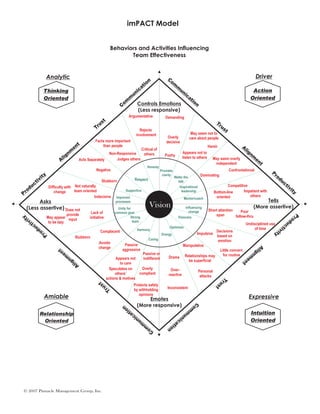
imPact Model
- 1. Trust © 2007 Pinnacle Management Group, Inc. Behaviors and Activities Influencing Team Effectiveness Analytic Argumentative Critical of others Rejects involvement Judges others Not naturally team oriented Negative Indecisive Difficulty with change Stubborn Acts Separately Non-Responsive Respect Supportive Honesty Impatient with others Competitive May seem not to care about people Confrontational Pushy Harsh Provides clarity May seem overly independent Appears not to listen to others Walks the talk Dominating Mentor/coach Demanding Overly decisive Inconsistent Poor follow-thru Relationships may be superficial Undisciplined use of time Little concern for routine Decisions based on emotion Impulsive Short attention span Over- reactive Protects safety by withholding opinions Passive or indifferent Speculates on others’ actions & motives Complacent Passive aggressive Appears not to care Lack of initiative Harmony Energy Caring May appear to be lazy Does not provide input Avoids change Stubborn Overly compliant Drama Manipulative Personal attacks Bottom-line oriented Facts more important than people T*Asks (Less assertive) Tells (More assertive) Emotes (More responsive) Controls Emotions (Less responsive) Driver Action Oriented Thinking Oriented Amiable Relationship Oriented Expressive Intuition Oriented Improved processes C om m unication C om m unication C om m unication C om m unication Trust Trust Trust A lignm ent A lignm ent A lignm ent A lignm ent Productivity Productivity Productivity Productivity Unity for common goal Visionary Influencing change Optimism Inspirational leadership Strong team Vision imPACT Model
- 2. Pinnacle Management Group, Incorporated imPACT Model™ Behaviors, Attitudes and Activities Influencing the Work Environment The imPACT Model™ was designed by Pinnacle Management Group to illustrate how typical behaviors, attitudes and activities can impact any organization. The following is a brief explanation of how to utilize this model: The model is divided into 4 quadrants each representing a personality style (Driver, Expressive, Amiable and Analytic). We have incorporated personality styles because it is an effective way to get everyone to understand his or her influence on the team. The 2 styles located in the upper quadrants typically control their emotions more than those in the lower quadrant. This creates a commonality for Driver and Analytic, and a commonality for Amiable and Expressive. Likewise, the two quadrants on the left are typically less assertive than those on the right creating a commonality for Analytic and Amiable, and a commonality for Driver and Expressive. This means that Driver and Amiable, and Analytic and Expressive have the least in common, creating greatest opportunities for tension and misunderstandings. This does not mean, however, that miscommunication cannot happen between any pairings. Next you will notice that each of the quadrants are broken into four elements – Communication, Trust, Alignment (how well the team is working toward a common vision of the future), and Productivity (how well resources are being utilized in a continuously improving manner). Each of the terms listed for the elements are typical behaviors, activities and attitudes that impact those elements. The Green, or productive, terms represent behaviors, activities and attitudes that are assisting the organization to move toward its vision for the future. The Red, or counter-productive, terms are moving the organization away from the vision. As a way to visualize this – Imagine that the black ring dividing the red and green terms represents when you walk in the door in the morning. From the time you turn on the lights, every activity that takes place is going to cost resources. Some of those activities will take you toward your goals, others will pull you away. Thus, if 713 Sainte Genevieve Avenue, Farmington, Missouri 63640 ~ 573-747-1951 ~ www.pmginternational.net
- 3. an activity is pulling you away, you are spending money to go in the wrong direction. In order to move toward your vision, you must then spend money to get back to your baseline (the black ring) to undue the damage done by the counter-productive activities. Then you must expend funds to continue to move forward toward your vision. Thus, it is easy to reason that an organization could expend $3 for every $1 of forward movement if there is not a concerted effort to minimize all counter- productive behaviors, activities and attitudes. This also accounts for the red having a much larger representation on the template than green. If you look at a term in one quadrant and trace to the opposite quadrant in the same element, you will see typical cause/effect relationships. For example, look at Driver’s communication. They may be perceived as being pushy. As a result, Amiables will tend to go passive when they encounter such behavior. The converse is also true. When an Amiable appears to be passive, a Driver can get pushier out of frustration. This helps individuals understand that they are often getting the wrong response from others because of their own actions. When behaviors, activities and attitudes remain in the green or productive, the responses received are almost always also in the green. For additional information, please contact us at 573-747-1951 or via email at info@pmginternational.net. Also, please visit our website at www.pmginternational.net.
